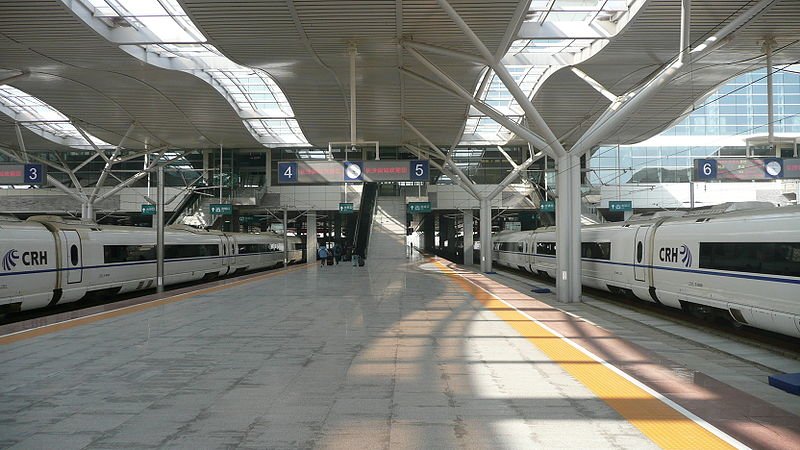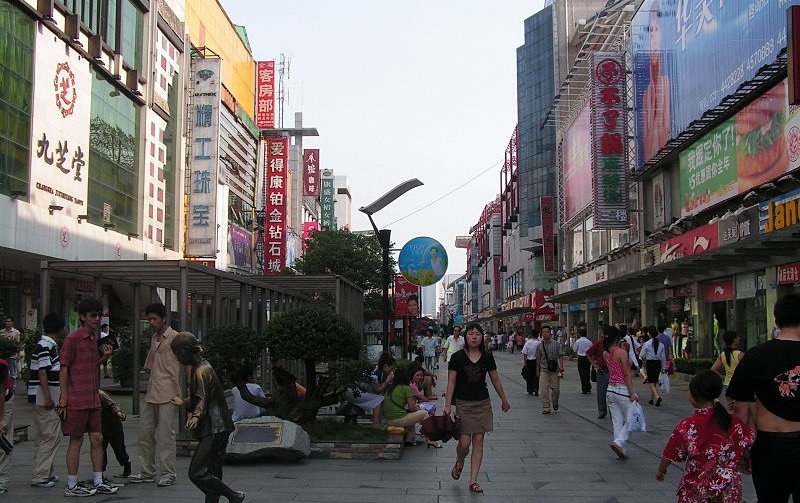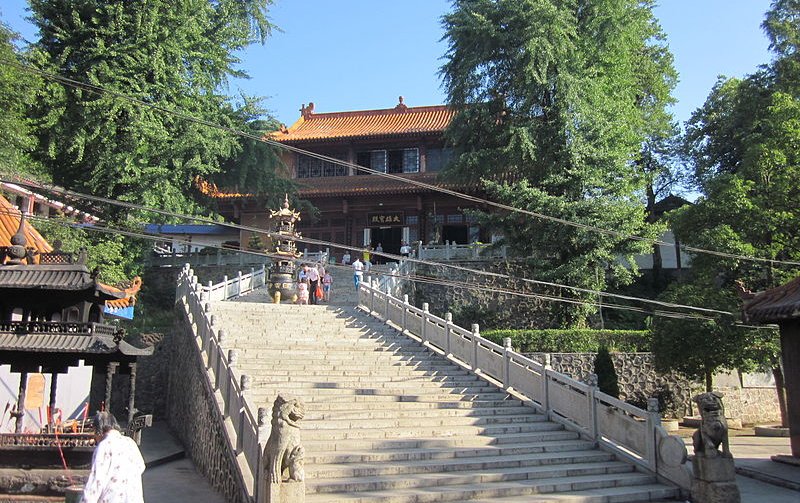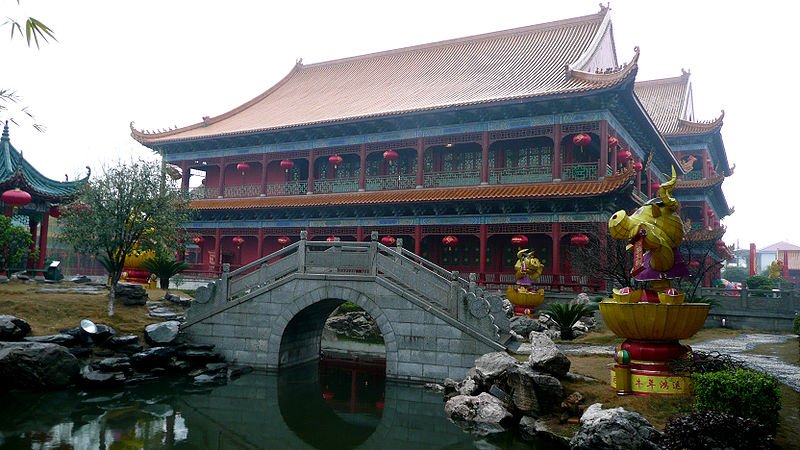 Changsha South Railway Station
Changsha South Railway StationSource: https://commons.wikimedia.org/wiki/File:Changsha_South_Railway_Station_10.JPG
Author: Brücke-Osteuropa

Author: Brücke-Osteuropa

Changsha (长沙) is the capital and biggest city in Hunan Province, China. The municipality of Changsa covers 11,819 sq km (4,563.3 sq mi) and has a population of 6.6 million people. The urban center of Changsha has a population of 2.7 million people.
Changsha straddles the Xiang River, a branch of the Yangtze River. The city experiences a humid subtropical climate. The warmest month here are July and August, when the temperature regularly exceeds 33°C (92°F). Coldest month is January, when temperature drops to 1.6°C (34.9°F). April is the wettest month, with 207 mm (8.2 in) of precipitation.
 Huangxing Road, Changsha
Huangxing Road, ChangshaSource: https://commons.wikimedia.org/wiki/File:Huangxing_road_in_Changsha.jpg
Author: Juansheng, Shizhao

The history of Changsha goes back to as early as the 1st millennium BC, when it was a settlement in the State of Chu. During Han Dynasty, it was already a capital of its namesake Changsha Kingdom. Changsha was made the capital of Hunan Province in 1664. Its economy was fueled by it being a major rice market.
The development of Changsha in the early 20th century can be attributed to railway links connecting it to Hankou in Hubei Province in 1918, from where the line extended to Guangzhou in Guangdong Province in 1936. Until 1937, the city depended mainly on trade, as it had not yet developed an industrial base. Its industrialization in the later part of the 20th century has enabled it to expand rapidly, tripling its population from 1949 to 1980.
The most famous person to be associated with Changsha is Mao Zedong. Between 1913 and 1918 he was a student at the Hunan No. 1 Teachers' Training College, where he would return later as a teacher and principal from 1920 to 1922. The college, which was destroyed during the Chinese Civil War, is now rebuilt, and now showcases memorabilia associated with Chairman Mao.
 Bai Yun Temple, Changsha
Bai Yun Temple, Changsha
Author: Juansheng, Shizhao

The history of Changsha goes back to as early as the 1st millennium BC, when it was a settlement in the State of Chu. During Han Dynasty, it was already a capital of its namesake Changsha Kingdom. Changsha was made the capital of Hunan Province in 1664. Its economy was fueled by it being a major rice market.
The development of Changsha in the early 20th century can be attributed to railway links connecting it to Hankou in Hubei Province in 1918, from where the line extended to Guangzhou in Guangdong Province in 1936. Until 1937, the city depended mainly on trade, as it had not yet developed an industrial base. Its industrialization in the later part of the 20th century has enabled it to expand rapidly, tripling its population from 1949 to 1980.
The most famous person to be associated with Changsha is Mao Zedong. Between 1913 and 1918 he was a student at the Hunan No. 1 Teachers' Training College, where he would return later as a teacher and principal from 1920 to 1922. The college, which was destroyed during the Chinese Civil War, is now rebuilt, and now showcases memorabilia associated with Chairman Mao.
 Bai Yun Temple, Changsha
Bai Yun Temple, ChangshaSource: https://commons.wikimedia.org/wiki/File:Bai_Yun_Temple_43.JPG
Author: Huangdan2060

Changsha is a major economic center for industries such as rice, cotton, timber and livestock. It is also a major power producer with a large thermal generating station. In the past decade, it had managed to attract billions of dollars in foreign direct investment. In 2008, Changsha had a nominal GDP of ¥300.1 billion (US$43 billion), equivalent to a per capita nominal GDP of ¥45,765 (US$6,589).
Changsha is today one of the top 20 economically advanced cities of China with a sizable middle class population. The city has the biggest Chinese restaurant in the world. Called the Xihulou, it has 4,000 seats. However its rapid growth comes with a high price, as the city now has to deal with environmental pollution and degradation.
 Xihulou Chinese Restaurant, Changsha
Xihulou Chinese Restaurant, Changsha
Looking for information on Penang? Use this Map of Roads in Penang to zoom in on information about Penang, brought to you road by road.

Author: Huangdan2060

Changsha is a major economic center for industries such as rice, cotton, timber and livestock. It is also a major power producer with a large thermal generating station. In the past decade, it had managed to attract billions of dollars in foreign direct investment. In 2008, Changsha had a nominal GDP of ¥300.1 billion (US$43 billion), equivalent to a per capita nominal GDP of ¥45,765 (US$6,589).
Changsha is today one of the top 20 economically advanced cities of China with a sizable middle class population. The city has the biggest Chinese restaurant in the world. Called the Xihulou, it has 4,000 seats. However its rapid growth comes with a high price, as the city now has to deal with environmental pollution and degradation.
Planning your trip to Changsha
The Changsha Huanghua International Airport (CSX) is located 20 km to the east of downtown Changsha. It is the main civilian airport for Hunan Province. The airport receives flights from major cities across China as well as from Hong Kong, Seoul and Taipei. Arriving at the airport, you can take the airport bus to downtown Changsha. The fare is ¥16.50 and the journey takes about 50 minutes. Xihulou Chinese Restaurant, Changsha
Xihulou Chinese Restaurant, ChangshaSource: https://commons.wikimedia.org/wiki/File:Xihulou_15.JPG
Author: Brücke-Osteuropa

Author: Brücke-Osteuropa

Exploring Changsha
The most practical way to go from place to place in Changsha, for a visitor, is to take the taxi. If you do not speak Chinese, have your destination written for you by your hotel, and make sure you keep a hotel name card to show the driver, for your return trip. The taxi fare starts at ¥6.00.Places of Interest in Changsha
- Hunan No. 1 Teacher's Training College
- Hunan Provincial Museum
- Hunan University
- Martyrs' Park
- Xihulou Chinese Restaurant
 Latest updates on Penang Travel Tips
Latest updates on Penang Travel Tips
 Map of Roads in Penang
Map of Roads in Penang
Looking for information on Penang? Use this Map of Roads in Penang to zoom in on information about Penang, brought to you road by road.
Copyright © 2003-2025 Timothy Tye. All Rights Reserved.

 Go Back
Go Back